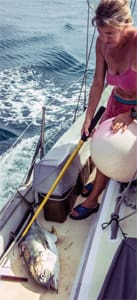To the editor: The recent article on sailing in Panama (“Jungle River Tactics,” May/June 2014) by Rich Ian-Frese shows a photo of a fish with the caption “Cat Ian-Frese admires a 40-inch yellowfin tuna caught on the sail returning to the Perlas Islands.”
The fish in the photo is clearly a crevalle jack, not a yellowfin tuna. Diagnostic features for the crevalle jack are the spot on the operculum or gill cover (tuna has none), spot on the pectoral fin (tuna has none), no finlets between pelvic fin and tail (tuna does have these), and general flattened body shape, (unlike a tuna which is almost round in cross section). Also, yellowfin tuna have a very different shaped mouth and forehead. The Pacific crevalle jack often has a yellowish anal fin and tinges to the tail, probably the source of confusion. And as Cat and Ian found out, (contrary to popular belief) crevalle jack are good to eat if prepared properly!
—Sam Johnston is a senior fisheries biologist at Hydroacoustic Technology, Inc. in Seattle.
Rich Ian-Frese responds: I stand corrected. What we assumed was a yellowfin does indeed, after studying the photo we took, appear to be a crevalle jack, as Sam Johnston asserts. I’m happy to see that someone is reading the fine print. Good call, Sam!

